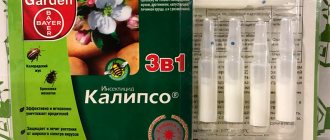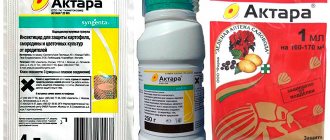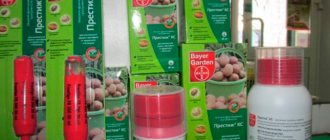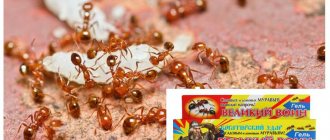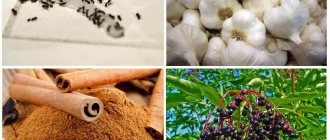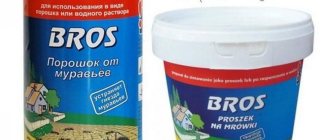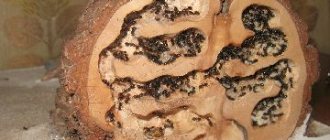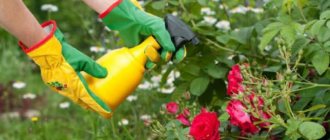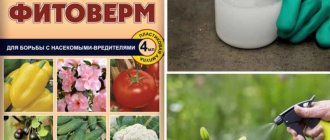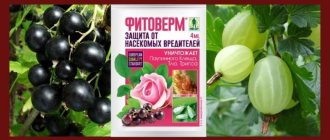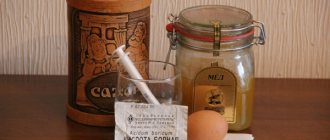One of the problems in the garden that causes a lot of trouble is ants. They spoil greens, flowers, fruits of plants, and are carriers of aphids, which ultimately causes great harm to the garden. In turn, another attack may await your home in the form of midges on indoor plants. As a result of their influence, the greens in pots dry out and die. Therefore, it is necessary to get rid of parasites in a timely manner using special means. Grom-2 is one of the drugs used against both ants and midges.
Content
- Purpose and use of the insecticide "Grom-2"
- a) ANTS
- b) SOIL FLIES
- Composition and preparative form "Grom-2"
- Mechanism of action
- Regulations for the use of "Grom-2"
- Consumption rates
- Restrictions and security
- Compatibility
- Resistance
- Analogues of "Grom-2"
- As a conclusion
The drug "Grom-2" is one of the most commonly used insecticides against ants, because: firstly, it works on the basis of the highly effective active ingredient DIAZINON, and secondly, the convenient granular form of the insecticide makes it easy to use.
| MORE DETAILS: SUMMARY TABLE of insecticidal preparations for ants (by active substance, areas of application, formulation) |
Preventive actions
If sciarids or flower midges find favorable living conditions in the apartment, it will be difficult to get rid of them. Therefore, you will have to find out the “tastes” of these insects and try to take preventive measures against their appearance and reproduction.
The main rule is to avoid waterlogging the soil in pots.
If you tend to flood your plants, then adjust the watering: waterlogging the soil in pots creates conditions for the active reproduction of sciarids. Never water a plant again if the soil on top of its pot is not dry! If you accidentally water the plant too much, drain the excess water from the pan and thoroughly dry the earthen ball before the next watering.
When insects appear, it is important to prevent their further reproduction and spread
Adult flying midges lay eggs on a damp soil surface, from which a large number of larvae live in the soil.
If the soil surface is dry, the masonry will die, so keeping the top layer of soil dry is an excellent preventive measure against sciarids. Dry the top layer of soil regularly (1-2 cm in medium-sized pots, up to 3-4 cm in larger ones).
Adult flying midges lay eggs on a damp soil surface, from which a large number of larvae live in the soil. If the soil surface is dry, the masonry will die, so keeping the top layer of soil dry is an excellent preventive measure against sciarids. Dry the top layer of soil regularly (1-2 cm in medium-sized pots, up to 3-4 cm in larger ones).
You can also use top drainage: cover the surface of the soil in the pot with a layer of fine expanded clay, gravel or coarse sand. After watering, such a layer quickly becomes dry and deprives insects of the opportunity to lay eggs.
Sciarids, like all insects, reproduce easily and very quickly - when the first flying individuals appear, take urgent measures to remove them.
Promptly remove dead parts of plants (withered leaves, flowers, underground parts) remaining in the pot. Monitor the state of the supply of vegetables and fruits in the apartment and your food waste, promptly remove and throw away everything that could become “home and food” for sciarids.
Use sterilized substrates for your plants.
It is good if the soil contains components that are “unpalatable” for midges: coarse fibrous peat, pine needles, bark, coal, coconut fiber. However, it must be remembered that the composition of the soil should first of all be selected in accordance with the needs of the plants, and not the needs of midges.
If you are not sure about the purity of the soil, spill it with water and freeze it for at least a few days (in the summer - in the refrigerator, in the winter - outside or on the balcony). It is safer to leave the soil prepared for future use on the balcony for the winter, and use it for replanting in the spring. Long-term freezing is a good remedy for many soil pests.
Purpose and use of the insecticide "Grom-2"
a) ANTS
The drug "Grom-2" is used in private households and farms to destroy ants in beds, flower beds, under trees, on garden paths, on blind areas of houses, on verandas and open terraces. In addition to ants, the drug has a protective effect against mole crickets, onion and cabbage flies, wireworms, furrow weevils, etc.
Ants are one of the “main” pests in the garden and vegetable garden.
| READ MORE: THREE main ways to get rid of ants on your property and in the greenhouse |
b) SOIL FLIES
The drug "Grom-2" is effectively used to protect potted flower plants and seedlings of vegetable and flower crops against soil flies and fungus gnats.
Soil flies and fungus gnats
Consumer Reviews
- “There have been ants on the site for a long time, but before I didn’t pay such great attention to it. Large anthills began to appear, and its inhabitants were very large, nasty and scary. I didn’t even know how to fight against such insects. I was helped by Grom, which is effective and of high quality. I can confidently recommend this drug to anyone who has the same problem as me. Say NO to all pests on the site!”
- “I never thought before that ants were pests. On the contrary, only the best reviews about these insects came across. Therefore, when anthills began to form, which were not only unsightly, but also spoiled the entire area with their usual presence, I decided to take action. Thunder actively helped me in this difficult matter. Now, I believe that granules are a unique product that not only attracts all ants, but also kills them.”
- “I’ve hated ants since childhood. Every time we are going somewhere, the first thought that comes to me is the abundance of ants. But, having purchased the Thunder product, I no longer notice these insects. It’s great that you can just scatter the granules!”
Protect your area from annoying insects. Try to purchase an effective remedy, Thunder, which will be an excellent assistant in this difficult task. Before you have time to look back, all the insects will immediately disappear, leaving both the anthill forever and the territory of the site itself. The main thing is to follow all the instructions and apply the product clearly, according to the specified plan, without deviating. Let there be no place for ants in your garden! Down with all the pests that only spoil the plants!
Mechanism of action
Organophosphorus insecticides, and diazinon in particular, are nerve poisons. Having an effect on the insect body, diazinon phosphorylates vital enzymes - esterases, suppressing their normal functioning. The active substance acts on cholinesterase, an enzyme that transmits nerve impulses. Cholinesterase binds, as a result it loses its activity and cannot cause hydrolysis of acetylcholine. If cholinesterase is blocked by a pesticide, then free acetylcholine accumulates in the synaltic cleft, the normal passage of nerve impulses is disrupted, tremor (convulsive muscle activity) occurs, which turns into paralysis, which subsequently leads to the death of the insect.
Microgranules of the drug "Grom-2" penetrate well into ant passages, act quickly and retain their active effect in the soil for a long time:
The speed of initial exposure is 1-2 days.
The duration of the protective effect is 1-1.5 months.
Release form, description of composition
Garden ant repellent is produced in the form of small granules. In summer cottages and gardens, the product is used in bags weighing 10 g. This amount is enough to treat 5 square meters. area. For large plots of land, sachets of the product weighing 50 g are sold.
The active component is a modern broad-spectrum insecticide - diazinon. Excipients - flavorings to attract the attention of insects, food additives.
Ant from soil-dwelling pests
The drug Muraviin has a contact-intestinal effect. When an ant enters the body, it disrupts the functioning of the nervous system. Blocks the transmission of impulses, provokes muscle paralysis. After a few seconds, death occurs.
The drug is toxic, but if the instructions are followed, it is safe for humans, animals, and earthworms. The microencapsulated form of the drug allows it to retain its properties for a long time, being under a layer of soil.
The ants hear the smell of the bait, find it, and drag it with them into the anthill. The whole family eats there, including the voracious larvae. They feed the uterus. Within a few days, the entire colony of pests becomes infected. Mass mortality is observed within 1-2 weeks.
The ant does not kill the larvae that are in the egg, but they will not be able to take care of themselves on their own after birth. As a result, the entire ant family dies from the action of the capsules.
Regulations for the use of "Grom-2"
The drug "Grom-2" is ready for use; there is no need to dilute it or mix it with anything, etc. Granules are added to anthills, places where ants gather and move, or scattered into pots or seedling boxes to get rid of soil flies.
| Application rate | Processed crop | Harmful object | Mode of application |
| 20-30 g/ 10 m2 | Vegetable and flower crops, strawberries, open ground, potatoes. Fruit trees near buildings | Ants | Adding granules to a depth of 2-3 cm, as well as in the expected paths of movement and accumulation of ants. |
| 2-3 g/ 10 m2 | Potted flower plants. Seedlings of vegetable and flower crops | Soil flies, fungus gnats | Applying granules to the soil surface and then incorporating them into the soil. |
Frequency of processing – once (1 time)
How to apply it correctly?
The use of fast-acting granules takes place in two or three stages. Let's designate them:
- First, you should remove the top layer of an anthill or other habitat (2-3 centimeters is enough).
- The dosage is indicated on the package (usually 3-4 grams for a small anthill, 6-7 grams for a large one). You can pour the granules onto your hands or directly onto the top of your home.
- If desired, you can cover the hole with a sheet of plywood or grass with leaves.
If insects live in crevices, cracks, or dry leaves, then it is recommended to simply add granules and leave them for a while.
Restrictions and security
"Grom-2" belongs to the 3rd class of danger to humans (moderately dangerous substance).
The release period is 7 days (fighting ants) and is not regulated when processing indoor plants and seedlings.
When interacting with the drug, generally known personal safety standards should be observed. Safety standards when working with the drug are in accordance with SanPiN 1.2.2584-10 “Hygienic requirements for the safety of testing processes, storage, transportation, implementation of the use, neutralization and disposal of pesticides and agrochemicals.”
The drug is not phytotoxic.
It should be borne in mind that diazinon poses a danger as a highly toxic pesticide only during the period of direct use, as well as for 20 days after use. During this time, it is detoxified, and toxic residues do not accumulate in the crop. The pesticide does not circulate in the environment.
The drug is registered and allowed for circulation in the Russian Federation for use on private farms. It is prohibited to use the drug in the water protection zone of water bodies.
| View/Download (.pdf file) CERTIFICATE of state registration of “GROM-2” (validity period, work schedule, etc.) |
Precautionary measures
When using insect repellents, you should always remember to take precautions if you do not want to get serious poisoning or burns to your skin. That is why it is imperative to use long rubber gloves, goggles and a respirator. It is advisable to cover your head with some kind of hat, which will then need to be washed thoroughly. After handling, wash your hands with soap, wash your face and rinse your mouth, as a small amount of toxic fumes may have entered your mouth.
If suddenly the insecticide gets into your mouth, you need to drink a lot of water and induce vomiting, and then consult a doctor to rinse your stomach. If this is not done, then you can get serious poisoning with not the most pleasant consequences.
Important!
Do not forget that if the treatment is carried out indoors, you must carefully ensure that children and pets do not get into this room. Also, the product should not get into water containers or aquariums.
Analogues of "Grom-2"
DIAZINON for the control of soil-dwelling and other insect pests is used either in the form of granules (active concentration 3-10%) or as an emulsion concentrate (active concentration 60%)
Preparations based on DIAZINON:
| a) for use in private household plots | Barguzin, G KE; Vallar, G; Great warrior against ants, gel; Grizzly, G; Thunder, G; Grom-2, G; Zemlin, G; Medvegon, G; Medvetoks, G; Anteater, K.E.; Muravyin, G; Provotox, G; Terradox, G; Muratsid, VE et al. |
| b) for use in agricultural production | Diazinon-600, EC; Diazol, EC; Sharp 600, CE; Practitioner, KE; Ricochet, K.E.; Enlil, KE et al. |
| B) for household and sanitary treatment | Trap-assault, gel; FAS, gel, etc. |
| MORE DETAILS: INSTRUCTIONS for the drug “Vallar, G” (for the larvae of the May beetle (chafer), wireworm and other soil-dwelling pests) |
Biological characteristics of the pest
Ants are highly organized insects and store all the most valuable things deep in the ground, where simple aerosols cannot reach. Contact drugs will not cope with an ant colony, because it consists of millions of individuals, and pesticides only affect working ants and cannot reach the queen with the larvae. The only option for getting rid of garden pests remains granules, gels and other poisonous baits, which worker ants voluntarily carry deep into the colony to feed them to the larvae and the queen, which becomes the end of the anthill.
Folk remedies for fighting ants
Popular folk methods of dealing with black ants include:
- treating anthills with a solution of boric acid and sugar (at the rate of two tablespoons of granulated sugar per one hundred milliliters of boric acid);
- treating nests with a mixture of oregano and wood ash, mixed in approximately equal proportions;
- destruction of anthills with a solution of water and kerosene (one tablespoon of kerosene per liter of water);
- watering ant paths and their habitats with vegetable oil.
Anthills at the dacha can be filled with boiling water; this can be done effectively in the evening, when the pests gather in the nest for the night. An even better result is achieved if you stir up the anthill immediately before doing this.
Other folk methods of fighting ants:
- Cut narrow strips of sheepskin and tie them around the shoots of plantings at a height of fifteen centimeters. Place the strips with the wool facing out. Additionally, lubricate them with carbolic acid, the aroma of which insects really dislike.
- Dig a shallow groove around the perimeter of the nest, pour a little carbon sulphide into it and onto the anthill and immediately set it on fire. The death of insects and the queen is guaranteed.
- Treat the beds with a mixture of ash, wood dust and lime. Ants cannot tolerate the strong smell of the components of this product and leave.
- Cover the beds with a thin layer of wood ash. Pour a strong solution of regular salt on top.
- Ants cannot tolerate the aroma of tomatoes. You can take advantage of this by treating the beds with a decoction of tomato tops. Try to prepare a solution as concentrated as possible.
- Place chopped garlic along the ant paths. The branches and leaves of wormwood and tomatoes placed right there will enhance the effect.
- Sprinkle the habitats and movements of ants with a collection of medicinal chamomile. It will not harm beneficial insects and plants and will drive out pests in just a couple of days.
Lures and traps
The use of baits allows you to quite effectively fight ants in the garden. They are located in places where insects gather and move, near their home. Among the popular recipes are the following:
- in three tablespoons of water, dissolve one tablespoon of sugar and a third of a teaspoon of borax, heat, stir, cool and add one teaspoon of honey;
- in half a liter of water, dilute half a teaspoon of boric acid and one tablespoon of sugar, mix well, pour into small containers;
- Dilute one tablespoon of yeast in cold water, mix thoroughly, add one teaspoon of sweet jam there and mix again, and then apply the bait to a piece of cardboard;
- mix four parts sugar, one part honey, half a part borax, five parts water and pour into suitable containers;
- Dilute a teaspoon of honey in one glass of water, pour into suitable containers and place in insect habitats;
- mix one part of honey or sugar with an equal part of boric acid, dilute in water and apply by drop method along the ant paths;
- combine some minced meat with borax in arbitrary proportions;
- mix equal parts of glycerin, borax, honey, water and sugar.
Also, to combat ants in a summer cottage, various types of traps with bait are used. You can make them yourself or purchase them ready-made in the store. Among the many varieties based on the principle of action, there are:
- glue traps (usually available in tape form);
- traps with various poisons;
- electronic devices (with the destruction of insects by electric current). >An electric trap kills not only ants, but also other insects.
The use of poisonous traps and baits requires compliance with certain safety rules. The main one is the exclusion of contact with the toxic substance of other animals and birds. Care is required when making them
Prevention measures about the main thing
In order not to return to the topic of how to remove midges from indoor plants, it is important to follow simple recommendations:
- Monitor the integrity of the drainage to prevent soil rotting.
- Maintain optimal soil moisture levels.
- Control the frequency of watering based on the time of year and type of plant.
- Clean plant trays regularly.
If midges have infested orchids, which are delicate plants that require special care, you can fight them using all the methods listed above. As a preventative measure, a regular solution with laundry soap is suitable.
To summarize all of the above, we note that midges in indoor plants are unpleasant and troublesome. You can get rid of insects using both industrial means and traditional methods. The best way to avoid a re-invasion is to adhere to preventive measures.
